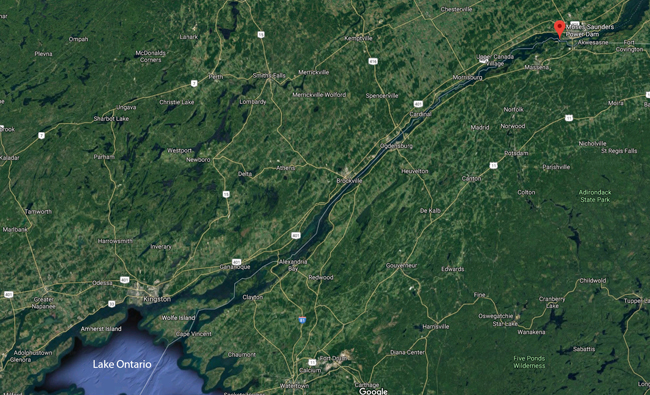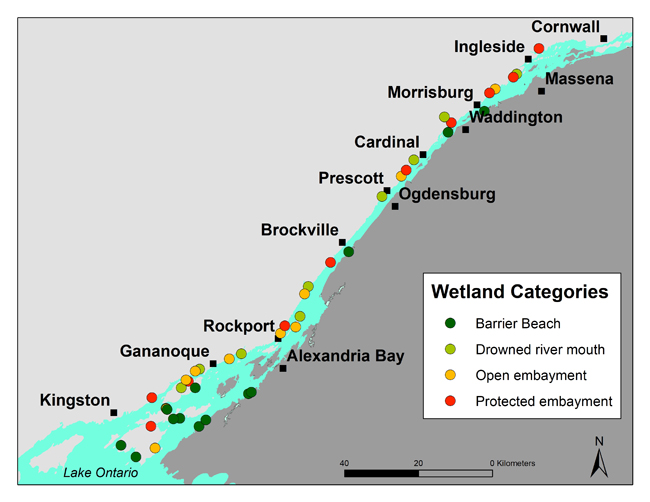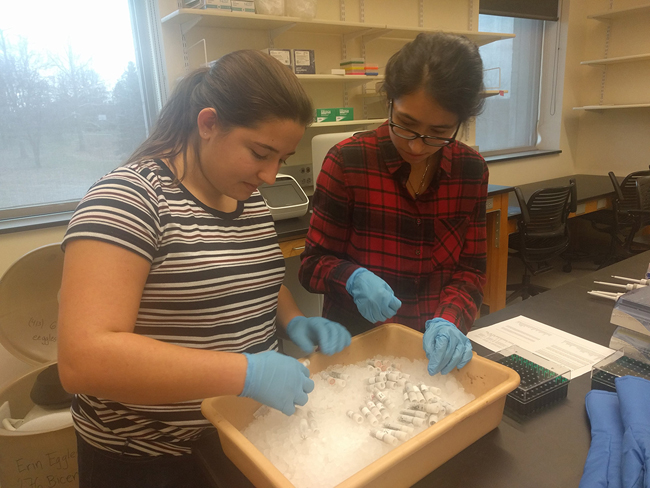—Published by Stephen Diehl for Middlebury College
NOTE: This research is related to a 2016-18 Great Lakes small grant funded through New York Sea Grant and the NYS Department of Environmental Conservation. The project, "Smart Infrastructure to Support Adaptive Management of the St. Lawrence River," was led by investigator Michael Twiss at Clarkson University. More on that and other projects in the series at "Great Lakes Small Grants Projects: Summaries (2015-17)."
Middlebury, Vermont, March 19, 2019 - Erin Eggleston, Middlebury College assistant professor of biology, and colleagues at Clarkson University believe a new water management plan at a power dam straddling the U.S.-Canadian border may create a serious health risk for people and wildlife living downstream.
For the past 60 years, the water flow in the Upper St. Lawrence River has been held static by the Moses-Saunders dam between Cornwall, Ontario, and Massena, N.Y. “Plan 2014” was approved by the International Joint Commission—the binational organization that oversees U.S.-Canadian boundary waters—in 2016 and implemented in 2017. The plan’s goal was to improve fish-spawning habitat and other ecosystem services through fluctuations in water level, but a new study suggests it may also have the unintended consequence of releasing neurotoxins into the river. Eggleston and her coauthors present their findings in an article accepted for publication in the Journal of Great Lakes Research this June.
Eggleston, a molecular microbial ecologist, says the plan’s new flow pattern, which raises and lowers the water level, could disrupt decades worth of industrial mercury stored in wetland sediment, and that microbes in the soil would likely convert that mercury into highly toxic methylmercury, creating a threat to the surrounding ecosystems.

A satellite image shows areas impacted by the new water management system, from the Moses-Saunders Power Dam in Cornwall, Ontario (red flag) through Lake Ontario.
“The negative effects of mercury mobilization have the potential to be felt across the food chain, because methylmercury accumulates in tissue and moves up the food chain into predatory species that are often consumed by people in this region,” said Eggleston. “Binational populations are studded along the St. Lawrence River, including indigenous Akwesasne populations just downriver from the dam. These powerful microscopic chemists, bacteria and archaea, living in these wetlands can have sizeable impacts on these ecosystems.”

Wetland mercury sampling sites along the upper St. Lawrence River. Graphic: Matt Windle.
Eggleston notes that microbes are incredibly diverse, having evolved over four billion years. They are the primary biological drivers of carbon, nitrogen, sulfur, and metal cycling.
“This project specifically allows me to use microbial community sequence analysis to ask which microbes are present that can potentially change mercury into methylmercury in wetlands along a major portion of the St. Lawrence.”
?Eggleston says the study suggests that about 190 pounds of mercury may be mobilized from the wetlands under the new water management plan. Data from her lab indicate that in all of the wetland soil samples tested, microbes are present that have the potential to carry out the toxic transformation.
“While we don’t know the rate at which these microbes will convert mercury to methylmercury, we think it is critical for the International Joint Commission, which has implemented this water management plan, to consider these data under an adaptive water management framework at the dam on the St. Lawrence River,” said Eggleston.

Rebecca Lightman ’19 (left) and Monica Melendez ’18 sort through frozen wetland soil samples prior to DNA extraction at the Eggleston lab in Middlebury.
Middlebury students also contributed to the research, working with Eggleston in her lab. Rebecca Lightman ’18 has been working to quantify a specific gene, hgcA, which has been shown to be essential for mercury methylation in microbes. Lightman extracts DNA from the wetland samples and quantifies how much of this gene is present in different wetland types. Eggleston hopes to compare the number of hgcA genes between 2016 and 2017, which would represent sampling before and after implementation of the new water plan. Monica Melendez ’18 and John Rustad ’18.5 helped set up Eggleston’s lab at Middlebury and helped with early DNA extractions.
Eggleston collaborated with Clarkson University graduate student Evie Brahmstedt, the lead author on the study, and Clarkson biology professor Michael Twiss. The project received funding from the New York Sea Grant Institute and the New York State Water Resources Institute. An In Press abstract of the article is currently available online. The full study will be published in the June 2019 issue of the Journal of Great Lakes Research.
More Info: New York Sea Grant
New York Sea Grant (NYSG), a cooperative program of Cornell University
and the State University of New York (SUNY), is one of 33 university-based
programs under the National Oceanic and Atmospheric Administration’s
National Sea Grant College Program.
Since 1971, NYSG has represented a statewide network of integrated
research, education and extension services promoting coastal community
economic vitality, environmental sustainability and citizen awareness
and understanding about the State’s marine and Great Lakes resources.
Through NYSG’s efforts, the combined talents of university scientists
and extension specialists help develop and transfer science-based
information to many coastal user groups—businesses and industries,
federal, state and local government decision-makers and agency managers,
educators, the media and the interested public.
The program maintains Great Lakes offices at Cornell University, SUNY
Buffalo, SUNY Oswego and the Wayne County Cooperative Extension office
in Newark. In the State's marine waters, NYSG has offices at Stony Brook
University in Long Island, Brooklyn College and Cornell Cooperative
Extension in NYC and Kingston in the Hudson Valley.
For updates on Sea Grant activities: www.nyseagrant.org has RSS, Facebook, Twitter, and YouTube links. NYSG offers a free e-list sign up via www.nyseagrant.org/nycoastlines for its flagship publication, NY Coastlines/Currents, which is published quarterly. Our program also produces an occasional e-newsletter,"NOAA Sea Grant's Social Media Review," via its blog, www.nyseagrant.org/blog.